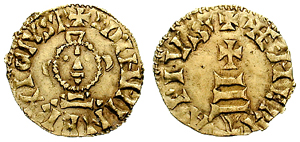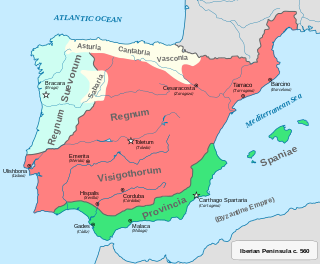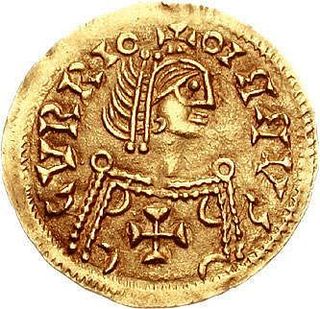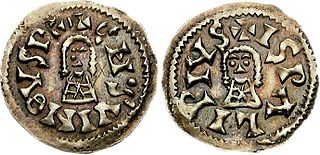
The Goths were Germanic people who played a major role in the fall of the Western Roman Empire and the emergence of medieval Europe.

The Ostrogoths were a Roman-era Germanic people. In the 5th century, they followed the Visigoths in creating one of the two great Gothic kingdoms within the Western Roman Empire, drawing upon the large Gothic populations who had settled in the Balkans in the 4th century. While the Visigoths had formed under the leadership of Alaric I, the new Ostrogothic political entity which came to rule Italy was formed in the Balkans under Theodoric the Great.

Theodoricthe Great, also called Theodoric the Amal, was king of the Ostrogoths (475–526), and ruler of the independent Ostrogothic Kingdom of Italy between 493 and 526, regent of the Visigoths (511–526), and a patrician of the Eastern Roman Empire. As ruler of the combined Gothic realms, Theodoric controlled an empire stretching from the Atlantic Ocean to the Adriatic Sea. Though Theodoric himself only used the title 'king' (rex), some scholars characterize him as a Western Roman Emperor in all but name, since he ruled a large part of the former Western Roman Empire described as a Res Publica, had received the former Western imperial regalia from Constantinople in 497 which he used, was referred to by the imperial title princeps by the Italian aristocracy and exercised imperial powers recognized in the East, such as naming consuls.

The Visigoths were a Germanic people united under the rule of a king and living within the Roman Empire during late antiquity. The Visigoths first appeared in the Balkans, as a Roman-allied barbarian military group united under the command of Alaric I. Their exact origins are believed to have been diverse but they probably included many descendants of the Thervingi who had moved into the Roman Empire beginning in 376 and had played a major role in defeating the Romans at the Battle of Adrianople in 378. Relations between the Romans and Alaric's Visigoths varied, with the two groups making treaties when convenient, and warring with one another when not. Under Alaric, the Visigoths invaded Italy and sacked Rome in August 410.

Septimania is a historical region in modern-day southern France. It referred to the western part of the Roman province of Gallia Narbonensis that passed to the control of the Visigoths in 462, when Septimania was ceded to their king, Theodoric II. During the Early Middle Ages, the region was variously known as Gallia Narbonensis, Gallia, or Narbonensis. The territory of Septimania roughly corresponds with the modern French former administrative region of Languedoc-Roussillon that merged into the new administrative region of Occitanie. In the Visigothic Kingdom, which became centred on Toledo by the end of the reign of Leovigild, Septimania was both an administrative province of the central royal government and an ecclesiastical province whose metropolitan was the Archbishop of Narbonne. Originally, the Goths may have maintained their hold on the Albigeois, but if so it was conquered by the time of Chilperic I. There is archaeological evidence that some enclaves of Visigothic population remained in Frankish Gaul, near the Septimanian border, after 507.

The Visigothic Code, also called Lex Visigothorum, is a set of laws first promulgated by king Chindasuinth of the Visigothic Kingdom in his second year of rule (642–643) that survives only in fragments. In 654 his son, king Recceswinth (649–672), published the enlarged law code, which was the first law code that applied equally to the conquering Goths and the general population, of which the majority had Roman roots, and had lived under Roman laws.

Chintila was a Visigothic King of Hispania, Septimania and Galicia from 636. He succeeded Sisenand and reigned until he died of natural causes, ruling over the fifth and sixth provisional Councils of Toledo. He wrote poetry as well. He was succeeded by his son from an unknown wife, Tulga.

Erwig was a king of the Visigoths in Hispania (680–687).

Recceswinth was the Visigothic King of Hispania and Septimania in 649–672. He ruled jointly with his father Chindaswinth until his father's death in 653.

Wittiza was the Visigothic King of Hispania from 694 until his death, co-ruling with his father, Egica, until 702 or 703.

Reccared II, was Visigothic King of Hispania, Septimania and Galicia briefly in 621, though the length of the reign exactly is debated to last from several days to just over a year.

Spania was a province of the Eastern Roman Empire from 552 until 624 in the south of the Iberian Peninsula and the Balearic Islands. It was established by the Emperor Justinian I in an effort to restore the western provinces of the Empire.

The Visigothic Kingdom, Visigothic Spain or Kingdom of the Goths occupied what is now southwestern France and the Iberian Peninsula from the 5th to the 8th centuries. One of the Germanic successor states to the Western Roman Empire, it was originally created by the settlement of the Visigoths under King Wallia in the province of Gallia Aquitania in southwest Gaul by the Roman government and then extended by conquest over all of Hispania. The Kingdom maintained independence from the Eastern Roman or Byzantine Empire, whose attempts to re-establish Roman authority in Hispania were only partially successful and short-lived.

Fidelis was the Bishop of Mérida flourishing probably in the 550s and 560s.
Claudius was a Hispano-Roman Catholic dux (duke) of Lusitania in the late sixth century. He was one of the most successful generals of Reccared I.
Segga was a Visigothic usurper who briefly claimed the kingship in 587 before being defeated by Reccared I.

Edward Arthur Thompson was an Irish-born British Marxist historian of classics and medieval studies. He was professor and director of the classics department at the University of Nottingham from 1948 to 1979, and a fellow of the British Academy. Thompson was a pioneer in the study of late antiquity, and was for decades the most prominent British scholar in this field. He was particularly interested in the relations between Ancient Rome and "barbarian" peoples such as the Huns and Visigoths, and has been credited with revitalizing English-language scholarship on the history of early Germanic peoples. Thompson's works on these subjects have been highly influential.

Chindasuinth was Visigothic King of Hispania, from 642 until his death in 653. He succeeded Tulga, from whom he took the throne in a coup. He was elected by the nobles and anointed by the bishops on April 30, 642.
Argimund was a Visigothic usurper who briefly claimed the kingship in 589–590 before being put down by the legitimate sovereign, Reccared I.
Frederic was a Visigothic Prince & general in the closing period of the Western Roman Empire and the rise of the Visigoths. He was the third son of Theodoric I, serving as General mainly in Gaul under his father & later brothers Thorismund & Theodoric II. Frederic's ability as a field commander is unknown. He was third in line for the throne behind his older brothers Thorismund & Theodoric the Younger. It is unknown if he took part in the Battle of the Catalaunian Plains where his father died, nor is it known what he did during the short reign of his eldest brother Thorismund (451–453). But it is somewhat known that Frederic accompanied his brother Theodoric II on multiple campaigns possibly from 456 to 463 in Gaul and Hispania after Theodoric's accession to the throne in 453 as the Goths expanded their influence in the crumbling Western Roman Empire after the deaths of Aetius and Valentinian III. However, he is rarely mentioned in ancient sources. All that is recorded of him is that he took part in the Battle of Aurelianum (463) against the Magister Militum of Gaul Aegidius. It was here that he was killed during the route of the Visigothic Army by the Gallo-Roman Forces. His death had serious repercussions in the Kingdom as Theodoric II would be murdered in early 466 by their youngest, but most ambitious brother Euric.